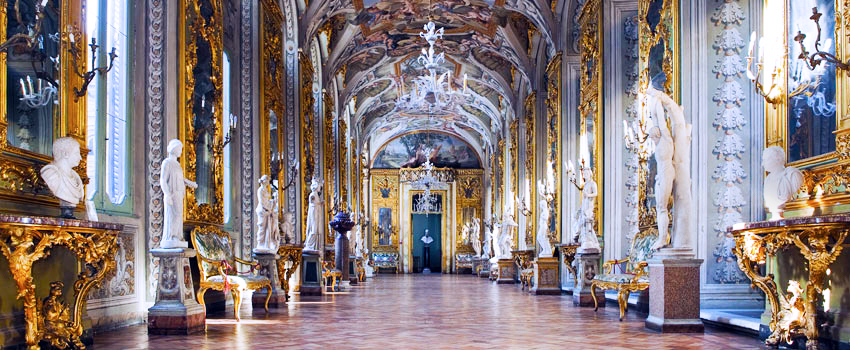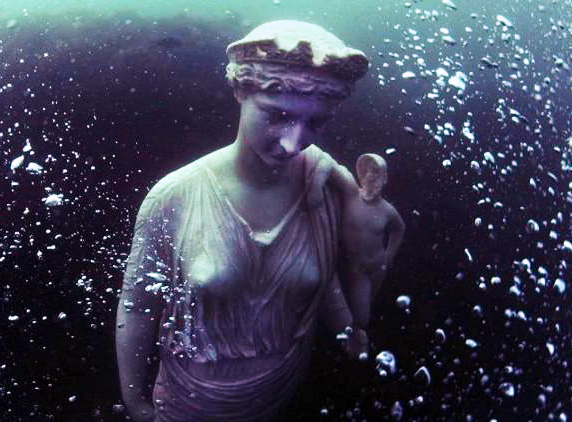If anyone contemplates a visit to Italy, two cities stand atop all of the other remarkable places to visit in the country – Florence and Rome. The Publisher’s Tour has visited each of these cities many times, but regardless of how many times one visits either of these cities, there are always new places to explore, restaurants to visit and old favorite haunts to see again.
Visitors to Florence are awed by Brunelleschi’s Dome and Campanile; inspired by Michelangelo’s statue of David and there are a wide range of museums, both grand and small, to enjoy the incomparable masterpieces in the city that is synonymous with art. There is the Pitti Palace and the Ponte Vecchio to explore, as well as scores of beautiful churches. It is impossible to contemplate a visit to Florence and not discuss the Galleria degli Uffizi.
First initiated in 1560 by Cosimo de’ Medici I, the vast spaces of the Uffizi were originally office space for the Florentine magistrates. The complex was completed 21 years later and soon thereafter, the immense space began housing the art collection of the Medici family. It was officially opened for public viewing in the late 18th century and is one of the most important museums in the world. The Uffizi holds a collection of priceless works, particularly from the period of the Italian Renaissance and is visited by over two million people each year. Visitors encounter awe-inspiring masterpieces by Botticelli, Michelangelo, Giotto and Titian, Raphael, Caravaggio and da Vinci. A visit to Florence is not complete without a visit to this museum.
Palazzo Vecchio is a fortress palace, with a 300 foot-high tower and remains the home to the mayor’s office and municipal council. From the top of the Torre d’Arnolfo, you can revel in one of the world’s most beautiful rooftop views. Inside, Michelangelo’s Genio della Vittoria sculpture graces the Salone dei Cinquecento.
Corridoio Vasariano is a half mile long covered passageway connecting Palazzo Vecchio with the Uffizi and Palazzo Pitti. It was designed by Vasari in 1565 to allow the Medici’s to wander between their palaces in privacy and comfort. In the 17th century, the Medici’s embellished the hallway with hundreds of pieces of artwork.
The Palazzo Pitti was commissioned by banker Luca Pitta in 1458. This vast Renaissance palace was later bought by the Medici family. Over the centuries, it served as the residence of the city’s rulers until the Savoys donated it to the state in 1919. Now it houses an impressive silver museum, art museums and a series of rooms re-creating life in the palace during House of Savoy times.
Florence’s Duomo is the city’s most iconic landmark. Topped by Filippo Brunelleschi’s red-tiled cupola, the cathedral’s pink, white and green marble facade and bell tower dominate the city’s medieval skyline. Inside are frescoes by Vasari and Zuccari and 44 inspiring stained-glass windows. But many of the art treasures formerly residing in the Duomo are now in museums. A stairway near the main entrance of the cathedral leads down to the crypt where excavations unearthed parts of the 5th century Chiesa di Santa Reparata that originally stood on the site. To learn about the Duomo, visit the Museo dell’Opera del Duomo. This museum tells the story of how the Duomo and its cupola were built through art and short films. Among its many treasures is Ghiberti’s original 15th century masterpiece, Porta del Paradiso – the Doors of Paradise. These gilded bronze doors are almost 53 feet tall and were designed for the eastern entrance to the Baptistery. While there, you can visit one of Michelangelo’s most beautiful works, La Pietà. Upon viewing this masterwork, consider that the sculptor was almost 80 years old when he completed the work.
The Galleria dell’Accademia was built to house one of the Renaissance’s most iconic masterpieces, Michelangelo’s David. Carved from a single block of marble, it is unquestionably the world’s most famous statue. The subtle details, such as the veins in the arms and the change in expression as you move around the statue are unforgettable. Michelangelo was also the master behind the unfinished San Matteo and four Prigioni, also displayed in the gallery. The Prisoners seem to be writhing and struggling to free themselves from the marble; they were meant for the tomb of Pope Julius II (see The Notorious Popes Part VI – Pope Julius II, January 11, 2018), but it was never completed. Adjacent rooms contain paintings by Andrea Orcagna, Taddeo Gaddi, Domenico Ghirlandaio, Filippino Lippi and Sandro Botticelli.
Nowhere is Medici wealth and privilege expressed so explicitly as in the Museo delle Cappelle Medicee. Adorned with granite, marble, semi-precious stones and some of Michelangelo’s most beautiful sculptures, it is the burial place of 49 dynasty members. Francesco I lies in the dark, imposing Cappella dei Principi, alongside Ferdinando I and II and Cosimo I, II and III. Lorenzo il Magnifico is buried in the graceful Sagrestia Nuova, which was Michelangelo’s first architectural work. It is also in the sacristy that you see three of Michelangelo’s most haunting sculptures: Dawn and Dusk on the sarcophagus of Lorenzo, Duke of Urbino; Night and Day on the sarcophagus of Lorenzo’s son Giuliano and Madonna and Child, which adorns Lorenzo’s tomb.
From Florence, the Publisher’s Tour went to the Eternal City for its final stop before heading home. There is a reason that Rome is one of the most popular tourist destinations in the world. You are immersed in culture and history, where old and new coexist and some of the most famous landmarks in the world are to be found. First-time visitors may be easily overwhelmed by all that this magnificent city has to offer. After all, one can find history and art on almost every street corner.
When looking back to the ancient Roman Empire, the famous Colosseum is likely to be the first image that comes to mind. It is nearby the Forum, but don’t forget the Pantheon and Palatine Hill. You will also step back in time when visiting the enormous Diocletian’s baths and Terme di Caracallato. Rome houses the world’s oldest museum – the Capitoline, but when it comes to history, works of art and architecture on remarkable scale, who could visit Rome without going to Vatican City with St. Peter’s Basilica, the Vatican Museums and the nearby Castel Sant’Angelo. From the Renaissance through the Baroque period remarkable works include the Basilica of St. John Lateran, the Trevi Fountain, Piazza di Spagna and the Spanish Steps. There is also the Piazza Navona, the site of the 1st century Stadium of Domitian, with its three famous fountains, its centerpiece being the Fontana dei Quattro Fiumi by Bernini.
Visitors stand in awe of the glory of magnificent palazzos, including Villa Borghese, Villa Farnesina, Villa Medici, Palazzo Barberini and the Palazzo Doria Pamphilj, which houses one of Rome’s richest private art collections. These treasures barely scratch the surface of Rome. There is the majesty of the 4th century Santa Maria Maggiore, or go below street level to the fascinating catacombs along the Appian Way, or to the Basilica di San Clemente, whose underground layers reveal how Rome built upon itself over the centuries. More recent, but unquestionably impressive, is the Monument to Italy’s first king – Vittorio Emanuele II.
St. Paul’s Outside the Walls
One of the enjoyable stops that the group made was to The Papal Basilica of St. Paul Outside the Walls, one of Rome’s four ancient basilicas. It is not in Vatican City, in fact it is located about one mile outside the Aurelian Walls that surrounded Rome, hence the name.
Consecrated in the 4th century, the basilica retained many of its original features throughout the centuries, but after an enormous fire in 1823, much of the original structure needed to be replaced. Reconstruction took until 1931. The basilica is second in size only to St. Peter’s in Vatican City and is one of the four major basilicas in Rome. It is the resting place of St. Paul, the Apostle, who arrived in Rome in 61 AD to be tried as a Christian. He was convicted and sentenced to death. The exact date of his beheading is unknown, but it occurred between 65 and 67 AD. The chains believed to have bound St. Paul are one of the many important relics of the basilica. Below ground, under the altar, is a marble tombstone which sits above a huge sarcophagus. Recently, an opening was made below the Papal Altar to allow the tomb to be seen.
For over 1,200 years, the Benedictine monks have been entrusted with the care of the St. Paul’s Outside the Walls. Their abbey is adjacent to the great basilica and in addition to their custodial work, the order produces their own brandy, which is outstanding.
There is far more to Rome than sightseeing. Shopping on every imaginable level fills the city, from the tawny stores of Via dei Condotti, to the quaint shops along the cobblestoned Via Margutta. If you are hungry, Rome has 78 Michelin Star restaurants – six more than New York City. There are restaurants and cafes to fit every taste and budget. Perhaps the best point to make about a visit to Rome is that since there is so much to see and to do, make sure to plan things out in advance and be sensible. You will never cover everything that Rome has to offer in a day or two, or three, for that matter! Perhaps you are best to get some advice from the experts, so call Fortunate Travel before booking your next trip to Italy. Buddy and Marion Fortunato, as well as all of the travelers on the Publisher’s Tour 2017 say “Fino all’anno prossimo, ciao, bella Italia!”
CAPTION (PIC 2)
ABOUT TO ENTER the Abbey are Frank Lepore, left, Mike Atiyeh and Joe Fabio.





